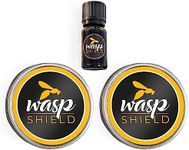Buying Guide for the Best Wasp Repellents
Choosing the right wasp repellent is crucial for ensuring a wasp-free environment, whether it's for your home, garden, or outdoor activities. The key is to understand the different types of repellents available and how they work, so you can select the one that best suits your needs. Consider factors such as the area you need to cover, the duration of protection, and any potential health or environmental concerns. By understanding these aspects, you can make an informed decision that effectively keeps wasps at bay while aligning with your personal preferences and requirements.Type of RepellentWasps can be deterred using various types of repellents, including sprays, traps, electronic devices, and natural solutions. Sprays are often used for immediate action and can be applied directly to nests or areas where wasps are active. Traps lure wasps away from certain areas and are ideal for outdoor spaces. Electronic repellents emit sounds or vibrations to keep wasps away and are a non-chemical option. Natural solutions, such as essential oils, are eco-friendly and safe for use around children and pets. Choose the type based on your specific situation, such as whether you need immediate action or a long-term solution.
Coverage AreaThe coverage area of a wasp repellent indicates how much space it can effectively protect. This is important to ensure that the entire area you want to keep wasp-free is covered. Smaller areas, like patios or balconies, may only require a small spray or trap, while larger gardens or outdoor events might need multiple traps or a more powerful electronic device. Consider the size of the area you need to protect and choose a repellent that can cover that space adequately.
Duration of EffectivenessThe duration of effectiveness refers to how long the repellent will continue to work after application. This is crucial for maintaining a wasp-free environment without constant reapplication. Some sprays offer short-term protection and need to be reapplied frequently, while traps and electronic devices can provide longer-lasting results. If you need continuous protection, such as for a garden or outdoor event, opt for a solution that offers extended effectiveness.
Safety and Environmental ImpactSafety and environmental impact are important considerations, especially if you have children, pets, or are concerned about the environment. Chemical sprays can be effective but may pose health risks or harm beneficial insects. Natural repellents, like those using essential oils, are generally safer and more environmentally friendly. Electronic devices offer a non-chemical alternative. Consider your personal safety preferences and environmental values when choosing a repellent.
Ease of UseEase of use refers to how simple it is to apply or set up the repellent. This is important for ensuring that you can quickly and effectively use the product without hassle. Sprays are typically straightforward to use, while traps may require some setup. Electronic devices might need installation or battery changes. Choose a repellent that matches your comfort level with application and maintenance.















